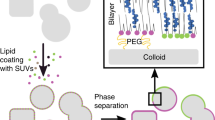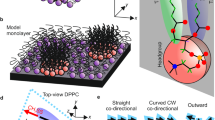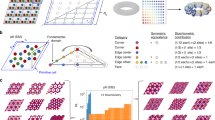Abstract
Liquid–liquid phase separation is ubiquitous in suspensions of nanoparticles, proteins and colloids. It has an important role in gel formation, protein crystallization and perhaps even as an organizing principle in cellular biology1,2. With a few notable exceptions3,4, liquid–liquid phase separation in bulk proceeds through the continuous coalescence of droplets until the system undergoes complete phase separation. But when colloids, nanoparticles or proteins are confined to interfaces, surfaces or membranes, their interactions differ fundamentally from those mediated by isotropic solvents5,6, and this results in significantly more complex phase behaviour7,8,9,10,11,12,13. Here we show that liquid–liquid phase separation in monolayer membranes composed of two dissimilar chiral colloidal rods gives rise to thermodynamically stable rafts that constantly exchange monomeric rods with the background reservoir to maintain a self-limited size. We visualize and manipulate rafts to quantify their assembly kinetics and to show that membrane distortions arising from the rods’ chirality lead to long-range repulsive raft–raft interactions. Rafts assemble into cluster crystals at high densities, but they can also form bonds to yield higher-order structures. Taken together, our observations demonstrate a robust membrane-based pathway for the assembly of monodisperse membrane clusters that is complementary to existing methods for colloid assembly in bulk suspensions14,15,16. They also reveal that chiral inclusions in membranes can acquire long-range repulsive interactions, which might more generally have a role in stabilizing assemblages of finite size13,17.
This is a preview of subscription content, access via your institution
Access options
Subscribe to this journal
Receive 51 print issues and online access
$199.00 per year
only $3.90 per issue
Buy this article
- Purchase on Springer Link
- Instant access to full article PDF
Prices may be subject to local taxes which are calculated during checkout




Similar content being viewed by others
References
ten Wolde, P. R. & Frenkel, D. Enhancement of protein crystal nucleation by critical density fluctuations. Science 277, 1975–1978 (1997)
Hyman, A. A. & Simons, K. Beyond oil and water-phase transitions in cells. Science 337, 1047–1049 (2012)
Stradner, A. et al. Equilibrium cluster formation in concentrated protein solutions and colloids. Nature 432, 492–495 (2004)
Groenewold, J. & Kegel, W. K. Anomalously large equilibrium clusters of colloids. J. Phys. Chem. B 105, 11702–11709 (2001)
Goulian, M., Bruinsma, R. & Pincus, P. Long-range forces in heterogeneous fluid membranes. Europhys. Lett. 23, 155 (1993)
Dan, N., Berman, A., Pincus, P. & Safran, S. A. Membrane-induced interactions between inclusions. J. Phys. II 4, 1713–1725 (1994)
Weis, R. M. & McConnell, H. M. Two-dimensional chiral crystals of phospholipid. Nature 310, 47–49 (1984)
Dietrich, C. et al. Lipid rafts reconstituted in model membranes. Biophys. J. 80, 1417–1428 (2001)
Dinsmore, A. D. et al. Colloidosomes: selectively permeable capsules composed of colloidal particles. Science 298, 1006–1009 (2002)
Lin, Y., Skaff, H., Emrick, T., Dinsmore, A. D. & Russell, T. P. Nanoparticle assembly and transport at liquid–liquid interfaces. Science 299, 226–229 (2003)
Veatch, S. L. & Keller, S. L. Separation of liquid phases in giant vesicles of ternary mixtures of phospholipids and cholesterol. Biophys. J. 85, 3074–3083 (2003)
Baumgart, T., Hess, S. T. & Webb, W. W. Imaging coexisting fluid domains in biomembrane models coupling curvature and line tension. Nature 425, 821–824 (2003)
Lingwood, D. & Simons, K. Lipid rafts as a membrane-organizing principle. Science 327, 46–50 (2010)
Meng, G. N., Arkus, N., Brenner, M. P. & Manoharan, V. N. The free-energy landscape of clusters of attractive hard spheres. Science 327, 560–563 (2010)
Chen, Q. et al. Supracolloidal reaction kinetics of Janus spheres. Science 331, 199–202 (2011)
Wang, Y. F. et al. Colloids with valence and specific directional bonding. Nature 491, 51–55 (2012)
Sarasij, R. C., Mayor, S. & Rao, M. Chirality-induced budding: a raft-mediated mechanism for endocytosis and morphology of caveolae? Biophys. J. 92, 3140–3158 (2007)
Barry, E. & Dogic, Z. Entropy driven self-assembly of nonamphiphilic colloidal membranes. Proc. Natl Acad. Sci. USA 107, 10348–10353 (2010)
Barry, E., Beller, D. & Dogic, Z. A model liquid crystalline system based on rodlike viruses with variable chirality and persistence length. Soft Matter 5, 2563–2570 (2009)
Sprague, B. L., Pego, R. L., Stavreva, D. A. & McNally, J. G. Analysis of binding reactions by fluorescence recovery after photobleaching. Biophys. J. 86, 3473–3495 (2004)
Gasser, U., Weeks, E. R., Schofield, A., Pusey, P. N. & Weitz, D. A. Real-space imaging of nucleation and growth in colloidal crystallization. Science 292, 258–262 (2001)
Crocker, J. C. & Grier, D. G. Microscopic measurement of the pair interaction potential of charge-stabilized colloid. Phys. Rev. Lett. 73, 352–355 (1994)
Barry, E., Dogic, Z., Meyer, R. B., Pelcovits, R. A. & Oldenbourg, R. Direct measurement of the twist penetration length in a single smectic A layer of colloidal virus particles. J. Phys. Chem. B 113, 3910–3913 (2009)
Tombolato, F., Ferrarini, A. & Grelet, E. Chiral nematic phase of suspensions of rodlike viruses: left-handed phase helicity from a right-handed molecular helix. Phys. Rev. Lett. 96 http://dx.doi.org/10.1103/PhysRevLett.96.258302 (2006)
Gibaud, T. et al. Reconfigurable self-assembly through chiral control of interfacial tension. Nature 481, 348–351 (2012)
Kaplan, C. N. & Meyer, R. B. Colloidal membranes of hard rods: unified theory of free edge structure and twist walls. Soft Matter 10, 4700–4710 (2014)
Rozovsky, S., Kaizuka, Y. & Groves, J. T. Formation and spatio-temporal evolution of periodic structures in lipid bilayers. J. Am. Chem. Soc. 127, 36–37 (2005)
Reynwar, B. J. et al. Aggregation and vesiculation of membrane proteins by curvature-mediated interactions. Nature 447, 461–464 (2007)
Ursell, T. S., Klug, W. S. & Phillips, R. Morphology and interaction between lipid domains. Proc. Natl Acad. Sci. USA 106, 13301–13306 (2009)
Seul, M. & Andelman, D. Domain shapes and patterns—the phenomenology of modulated phases. Science 267, 476–483 (1995)
Dogic, Z. & Fraden, S. Development of model colloidal liquid crystals and the kinetics of the isotropic–smectic transition. Phil. Trans. R. Soc. A 359, 997–1014 (2001)
Maniatis, T., Sambrook, J. & Fritsch, E. Molecular Cloning (Cold Spring Harbor Laboratory, 1989)
Lettinga, M. P., Barry, E. & Dogic, Z. Self-diffusion of rod-like viruses in the nematic phase. Europhys. Lett. 71, 692–698 (2005)
Lau, A. W. C., Prasad, A. & Dogic, Z. Condensation of isolated semi-flexible filaments driven by depletion interactions. Europhys. Lett. 87, 48006 (2009)
Oldenbourg, R. & Mei, G. New polarized-light microscope with precision universal compensator. J Microsc. 180, 140–147 (1995)
Zakhary, M. J. et al. Imprintable membranes from incomplete chiral coalescence. Nature Commun. 5 http://dx.doi.org/10.1038/ncomms4063 (2014)
Gardiner, C. W. Handbook of Stochastic Methods (Springer, 1985)
Crocker, J. C. & Grier, D. G. Methods of digital video microscopy for colloidal studies. J. Colloid Interf. Sci. 179, 298–310 (1996)
Acknowledgements
We acknowledge discussions with R. B. Meyer. This work was supported by the US National Science Foundation (NSF-MRSEC-0820492, NSF-DMR-0955776 and NSF-MRI-0923057) and the Petroleum Research Fund (ACS-PRF 50558-DNI7). We acknowledge use of the Brandeis MRSEC optical microscopy facility.
Author information
Authors and Affiliations
Contributions
P.S., A.W. and Z.D. conceived and designed the experiments. P.S. and A.W. performed the experiments. M.F.H. designed the theoretical models. P.S., A.W., Z.D. and M.F.H. interpreted the experiments. T.G. provided material samples. P.S. and Z.D. wrote the manuscript.
Corresponding author
Ethics declarations
Competing interests
The authors declare no competing financial interests.
Supplementary information
This video shows coalescence of membranes composed of pure short rods (left) and pure long rods (right) as viewed in DIC imaging.
The long-short rod interface destabilizes to form rafts of well-defined size connected by thin bridges, which eventually break through thermal fluctuations. Scale bar, 2.56 μm. (MOV 1913 kb)
This video shows the fluorescence imaging time lapse of the intensity of rafts after they have been photo-bleached with a focused laser beam.
Some of the rafts have not been photo-bleached to highlight the difference between an unbleached and a photo-bleached raft. Short rods are fluorescently labeled and long rods are unlabeled, which causes the unbleached short-rod-rich rafts to appear bright and the short-rod-poor membrane background to appear dim. Scale bar, 2.7 μm. (MOV 2492 kb)
This video shows the time evolution of the polydisperse-sized rafts over a period of 19 hours as viewed in fluorescence imaging wherein only short rods are labeled (bright pixels).
Please note that at equilibrium, all rafts have nearly the same size. Using optical traps, a small fraction of rafts are broken into smaller rafts and others are merged into larger rafts (process not shown in the video). The three rafts seen in the video are marked by red, green and magenta circles, which are to highlight the three types of evolution observed. The raft marked by a red circle shrinks completely by losing all its rods into the background membrane. The rafts marked by green and magenta circles grow and shrink in size, respectively, with increasing time. Scale bar, 3.4 μm. (MOV 5899 kb)
Each frame of the video is a composite image of phase contrast and fluorescence microscopy.
Phase contrast and florescence images were acquired simultaneously and were subsequently overlaid. Longer rods are unlabeled. 1 out of 30,000 short rods are labeled and appear as isolated red spots. The phase contrast channel is false colored with rafts colored in yellow and the membrane background in green. The labeled rods diffuse within the membrane background. On reaching a raft interior, they reside in it with an average lifetime of a few minutes before eventually leaving the raft. Scale bar, 2.56 μm. (MOV 3740 kb)
This video demonstrates blinking optical trap technique.
Two optical plows composed of multiple light beams (each beam indicated as a red dot) push a raft pair into close proximity. Subsequently, optical plows are switched off and rafts move away from each other under the influence of repulsive interactions. (MOV 1816 kb)
This video shows fluorescence imaging time lapse of rafts in a membrane for three different long and short rod stoichiometric ratios at the same dextran concentration of 40mg/ml.
Short rods are fluorescently labeled and long rods are unlabeled. Rafts embedded in the host membrane exhibit a dilute gas-like structure at low number density of rafts. Short-range order sets in at intermediate raft densities. Rafts self-organize into a 2-D hexagonal lattice at the highest number density. Scale bar, 2.56 μm for the low and intermediate raft densities and 2.0 μm for the highest raft density. (MOV 6662 kb)
This video shows supra-clusters formed by stabilizing the thin liquid bridges between rafts in fluorescence imaging mode.
Short rods are fluorescently labeled and long rods are unlabeled. The video was made by combining three different image stacks that were acquired under the same experimental conditions. They are clearly demarcated in the video with thin long white lines. Various shapes of supra-clusters are observed depending on the number of rafts bound in the cluster. All Scale bars, 2.56 μm. (MOV 3174 kb)
This video shows fluorescence imaging time lapse of a “bead on a string” polymer-like chain assembled by connecting nine rafts into a chain.
The chain surprisingly maintains a preferential bond angle of 1100. Scale bar, 2.56 μm. (MOV 388 kb)
Rights and permissions
About this article
Cite this article
Sharma, P., Ward, A., Gibaud, T. et al. Hierarchical organization of chiral rafts in colloidal membranes. Nature 513, 77–80 (2014). https://doi.org/10.1038/nature13694
Received:
Accepted:
Published:
Issue Date:
DOI: https://doi.org/10.1038/nature13694
This article is cited by
-
Symmetry control of nanorod superlattice driven by a governing force
Nature Communications (2017)
-
Molecular engineering of chiral colloidal liquid crystals using DNA origami
Nature Materials (2017)
-
Entropy-driven formation of chiral nematic phases by computer simulations
Nature Communications (2016)
-
Condensation and dissolution of nematic droplets in dispersions of colloidal rods with thermo–sensitive depletants
Scientific Reports (2015)
Comments
By submitting a comment you agree to abide by our Terms and Community Guidelines. If you find something abusive or that does not comply with our terms or guidelines please flag it as inappropriate.



